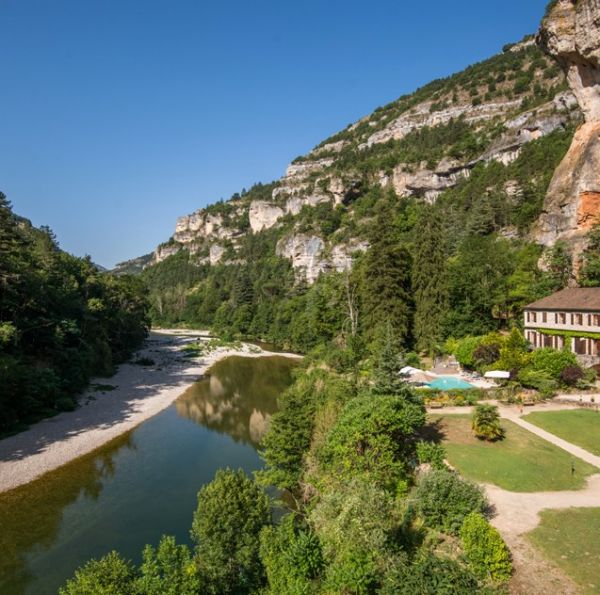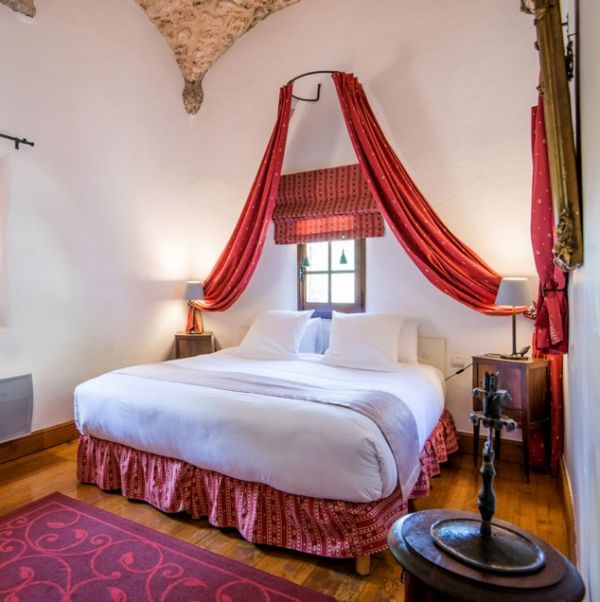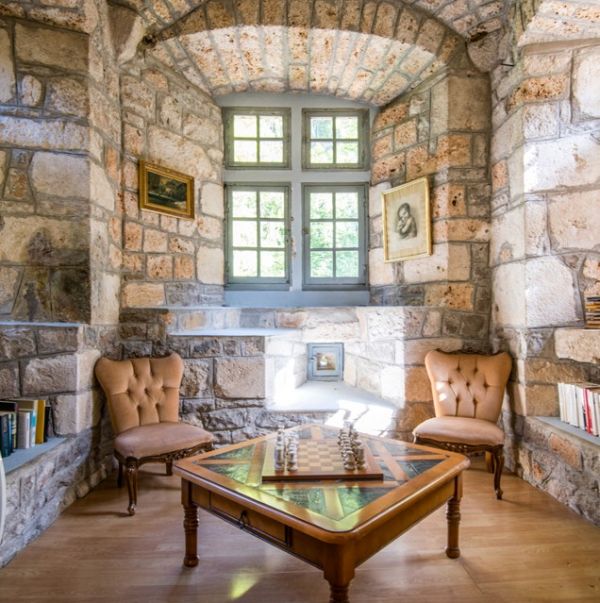
Hotel of the Gorges du Tarn
In the heart of the Gorges du Tarn, between sky and river, stands a castle straight out of a dream. Golden cliffs, a secret forest, the murmur of water... Château de la Caze welcomes you to the unspoiled setting of Lozère nature. Discreet luxury and medieval charm blend together for a timeless interlude.
Hotel restaurant in Sainte-Énimie
Listed as a Historic Monument, our 4-star hotel welcomes you to a fully restored 15th-century building. Its location between Sainte-Énimie and La Malène makes it an ideal starting point for exploring the Gorges du Tarn. As a couple, family, or friends, experience an authentic stay in the heart of unspoiled nature.
The comfortable rooms of your charming hotel in Lozère
The rooms at Château de la Caze combine the elegance of period decor with modern comfort. Antique furniture, exposed beams, and unobstructed views of the cliffs and grounds: every detail invites relaxation.
The hotel has 10 rooms nestled in the heart of the castle, as well as 6 contemporary suites located in La Maison de Martine , just 40 meters away. This elegant, air-conditioned annex offers stunning views of the castle and gardens.
Each suite includes a seating area with a sofa bed, perfect for family stays. Three suites are located on the ground floor, without stairs, including one specially designed and accessible for guests with reduced mobility, for optimal comfort.
All our rooms are equipped with a private bathroom, a hairdryer, a safe, a minibar, slippers and bathrobes, as well as free Wi-Fi.
Laundry service and continental breakfast complete your comfort.
Your restaurant in the Gorges du Tarn
Discover your restaurant, nestled within the centuries-old castle walls, between a Gothic fireplace and a high terrace protected by boxwood hedges. An invitation to savor local produce in a setting steeped in history.
Our chef offers gourmet and refined cuisine, inspired by Lozère, the seasons, and her own creativity. Trout from our rivers, Aubrac lamb, seasonal fruits... each dish pays homage to the flavors of the land and local producers.
The restaurant is open every evening, and also for lunch on weekends, with a short, frequently changing gourmet menu. This deliberate choice allows our chef to showcase fresh, local, and seasonal produce, allowing us to offer you consistent excellence.
Daily suggestions regularly complement the menu, depending on arrivals and current inspiration.
To accompany your meal, our sommelier offers a careful selection of wines, combining fine regional wines and discoveries from elsewhere.
All the services of your Gorges du Tarn hotel with swimming pool
Enjoy all the services designed for your well-being, in a calm and natural setting. Here, relaxation is guaranteed, whether you're looking for rest or sports.
Château de la Caze offers a heated outdoor swimming pool, a jacuzzi with views of the cliffs, an outdoor fitness area (rowing machine, elliptical trainer, etc.), a massage area, and a lounge bar. You also have access to a private beach on the banks of the Tarn, ideal for cooling off after a day of walking.
Our establishment also provides you with a heliport.
For children, the park offers beautiful spaces for play and walking. The vegetable garden, century-old trees, boxwood hedges, and landscaped trails provide a gentle immersion in nature. Private parking, a laundry service, and free Wi-Fi complete the amenities.
Organize your wedding in the 48
Dreaming of a castle wedding? Treat yourself to the magic of a unique location, by the water and under the watchful eye of the cliffs. Available for private hire, the Château de la Caze welcomes your receptions with elegance and serenity.
In this historic setting, everything has been designed to make your wedding a unique moment: a romantic park, intimate lounges, a terrace protected by the moat... The castle can be privatized from the big day at 4 p.m. until the following day at noon. The 16 rooms can accommodate some of your guests on site.
Our team is with you every step of the way: logistics, accommodations, catering, decorations, etc. You can also organize a brunch the next day, in the gardens or indoors. And for small weddings, our indoor lounges are perfect for intimate ceremonies. Surrounded by nature, 1 hour from Mende and 2 hours from Montpellier and Clermont-Ferrand, this venue is a true haven.
The beautiful story of our castle hotel in Lozère
Our hotel is a former pleasure castle, built in 1490 by François Alamand for his niece Soubeyrane. Carefully restored, it retains all the charm of a medieval residence, nestled in lush greenery.
Listed as a Historic Monument since 1936, the Château de la Caze is located between the Méjean and Sauveterre causses, in the heart of the Grands Causses Regional Natural Park. It has been a family home, a holiday residence, and then a charming hotel. Its restoration was carried out with respect for its heritage, while incorporating modern amenities essential to today's comfort.
The thick walls, exposed beams, Gothic fireplace, corner towers, and moat create a unique atmosphere. Far from flashy luxury, the elegance here is subdued, inspired by the natural elements and the memory of the place. An immersion in time, without sacrificing the essentials.
Hotel restaurant of the Gorges du Tarn
Enjoy a comfortable stay in a boutique hotel with high-end services and a personalized welcome. Here, every moment is immersed in an exceptional setting, nestled between nature and heritage. An ideal place to discover the charm of the Gorges du Tarn and Lozère.
Visit the Gorges du Tarn from our luxury hotel in Lozère
The hotel is ideally located for exploring the treasures of Lozère. Just 5 minutes from Sainte-Énimie and 10 minutes from La Malène, on the banks of the Tarn River, the château allows you to explore the surrounding area at your own pace.
From the hotel, head out for a hike along the Causses trails or try your hand at canoeing directly from the private beach. For a more relaxed experience, embark with the Bateliers de la Malène for a guided boat trip.
Looking for an adrenaline rush? Try caving, canyoning, or via ferrata with our local partners. Those who love picturesque villages can visit Saint-Chély-du-Tarn, Ispagnac, or Florac, all located less than 45 minutes away. For nature lovers, the Gorges du Tarn offer exceptional biodiversity in the heart of the Cévennes National Park. Our team will help you plan your outings, tailored to your needs and skill level.
An easily accessible hotel and restaurant in the Gorges du Tarn
To reach Château de la Caze, follow the meandering Tarn River until it reveals one of its best-kept treasures. Private parking awaits you at the entrance to the estate.
Located 45 minutes from the A75 (exit 40 – La Canourgue), the hotel is easily accessible by car from Mende (1 hour), Rodez (1.5 hours), Montpellier (2 hours) or Clermont-Ferrand (2.5 hours). The nearest train station is in Marvejols (50 minutes), with regular connections from Clermont or Béziers. The hotel offers a shuttle service between the stations of Marvejols, Mende and Millau, upon reservation 48 hours in advance.
Rodez Airport is 100 km away. Electric bikes can be rented in nearby villages to explore the surrounding area at your own pace. Château de la Caze also has a helipad for those wishing to arrive by air.






























